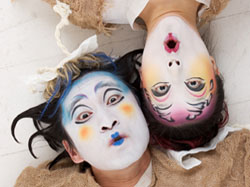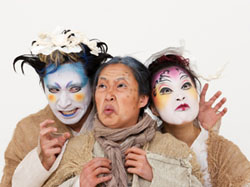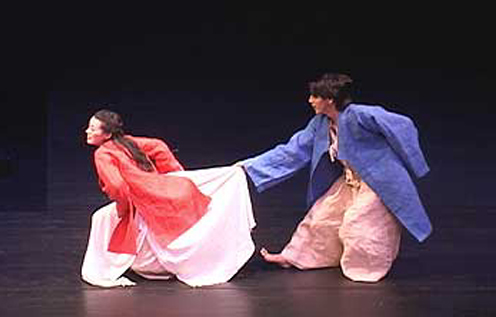|
Throughout its history of 5,000 years, Korean theatre was strongly influenced by Shamanistic and Buddhist rites. Talnori, or mask dance drama, assumed its present form in the mid-13th century, using theatrical acrobatics and dance, and addressing real-life issues and problems such as the corruption of the apostate Buddhist monks, and the suffering of women under the patriarchal, polygamous society. Koktugakshinori (puppet plays) dating back to the 18th century was played by professional troupes, and dealt with similar issues to Talnori, narrated by an ubiquitous character, called Pakchomji. Pansori, a narrative and dramatic singing by one vocalist and accompanied by a drummer, has been another important theatrical genre since the late 17th century. Changguk, or Korean traditional opera, developed from Pansori and incorporated some aspects from Western theatre. Instead of one vocalist singing and narrating, Changguk employs divided roles and as many performers to play them.
Between the 1920s and the liberation from the Japanese control, Western drama was embraced as a dynamic education tool. Shakespeare was first translated in this period and has become the most prominent influence on Korean theatre ever since. However, the majority of the plays introduced around this time were by modern European dramatists. These included Henrik Ibsen, August Strindberg, Anton Chekhov, Leo Tolstoy, Ivan Turgenev, Lady Gregory, G. B. Shaw, Oscar Wilde, Victor Hugo, Gerhart Hauptmann and Eugene O'Neill. Korean intellectuals used theatre to enlighten the populace about modern Western ideas of democracy, the rights of individuals, and to encourage national consciousness. European realist and naturalist dramas were most often produced. This helped Korean theatre to shift from a sentimental, exaggerated approach to staging to more natural, true-to-life one. Stanislavsky was introduced in this time period.
Korean Modern Theatre has been based on a dual structure. On one hand exists the Korean traditional culture, while on the other the so-called advanced Western culture. Thus, like most Asian countries, Korean modern theatre of its national and cultural identity has to do with the cross study of Korean traditional heritages and Western theatrical influences
Today's Korean theatre is hard to describe outside of the context of its relation to Western drama. This was sometimes used as a tool for enlightment, as a political alternative, or simply as a stimulant for creativity.
Yohangza is a South Korean Multi award-winning physical theatre company and was established in 1997 by director/writer of Jung Ung Yang. Winning Best Production at 15th Cairo International Festival of Experimental Theatre for Karma in September 2003 as well as numerous local awards, its performances have struck a chord with audiences, both Korean and international.
Distinctly Korean in flavour, their plays takes the audience through the passage of life that every human being experiences - birth, growing up, marriage and death using the modes of gestures, movements and facial expressions with a mix of energetic dance and music in an experimental manner. Yohangza's work presents an exciting collision of the past and the present; a reworking of existing Korean styles and themes infused with contemporary elements and driven by a thirst for experiment.
 |
 |
With a very antique tradition dating back to 7th and 8th centuries, the eastern theatre company retains its original precepts at the same time it continues developing, shown by its performance on screen and in other art locations. The result is a compelling and fresh mix of energetic dance, voice and percussion interwoven with stories from Korean folklore, mythology and history. Each piece is a sensory and aesthetic journey that pulls us into a past Korea that is undoubtedly connected to Korea's identity and spirit.
In November 2003 they were invited to Japan to perform their unique version of 'A Midsummer Night's Dream', which is since touring throughout the world (Festival de Manizales and Bogotá Theatre Festival in 2004, the Edinburgh Festival, El Salvador and the Festival Internacional de Teatro de la Habana in 2005)
Shakespeare in another language doesn't sound much fun and when it's lead by the verse with the movement following it's generally not. But Yohangza Theatre Company have reversed the convention, demoted the spoken word to second place and created a piece of theatre so astounding in it's physicality, it makes no difference the average audience member won't understand much of what's being said.
Yohangza makes physical theatre an extreme sport in their spectacular retelling of Shakespeare's comedy. Korean folklore breathes new magic into the tale, with its mischievously humorous Dokkebi goblins. It's a truly multilingual performance narrated in a foreign tongue and through the combined languages of dance, percussion and mime, but the Korean cast lose nothing in translation. When lights are dimmed, they dance with glowing bangles to welcome us to their dreamscape. Percussion immerses the nocturnal forest in surround sound, the performers dispersed through the auditorium to produce an orchestra of insect noise and beastly howls.
The Korean company introduces "Dokkebi," or goblins, with a view to make the original play into a Korean-style fairy tale. The names of main characters have been borrowed from the 28 heavenly stars such as Hang, Byeok, Ru, and Ik - names which are familiar with many older Koreans. The idea behind the original production came from the National Theatre of Korea, which staged five Shakespearean plays in a row under the title of "Shakespeare Nanjang" from April to May of this year. The plays were held at an outdoor theatre in an attempt to recreate the atmosphere of the original Shakespearean venue.

All the main characters are represented, but there are subtle changes and role reversals in their Korean counterparts. Shakespeare's Oberon is the dominant partner who casts a spell on his wayward fairy queen Titania, but in the South Korean version it is the Dokkebi queen Dot who wears the trousers. She has her husband Kabi fall for the grotesque Bottom character, an elderly woman the fairies have transformed into a pig. Duduri is played by two actors, at times manoeuvring as a single body and at others dividing into a Puck-ish double-act.
It is a spectacle in the very best sense of the word: the costumes, headdresses and masks are evocative of the forest, the butterfly-wing make-up is lovely, and there is the sense that huge amounts of time have been invested in making this look as good as possible. Modern technology is also applied: smoke, fluorescent bracelets to light up the suggested forest, and pure dramatic imagination. Everything has been painstakingly choreographed and is performed to perfection – this ensemble is absolutely professional and Yang Jung Ung's direction is inspiring.
The music, composed by Kim Eun Jeong, is simply arranged but powerful, and perhaps the key to this production is balance: everything is exquisite but there is no element that dominates at the expense of any other.
Yohangza's "A Mid-summer Night's Dream." is heading into Britain once more in 2006 at London's Barbican Center, where the play will be staged next June. It is said that the centre decided to invite the troupe after seeing its performance. It is an experimental and innovative theatre company, with an effective light design. Korea takes on Elizabethan theatre without betraying it and brings to it its own idiosyncrasies. An absolute must!
|